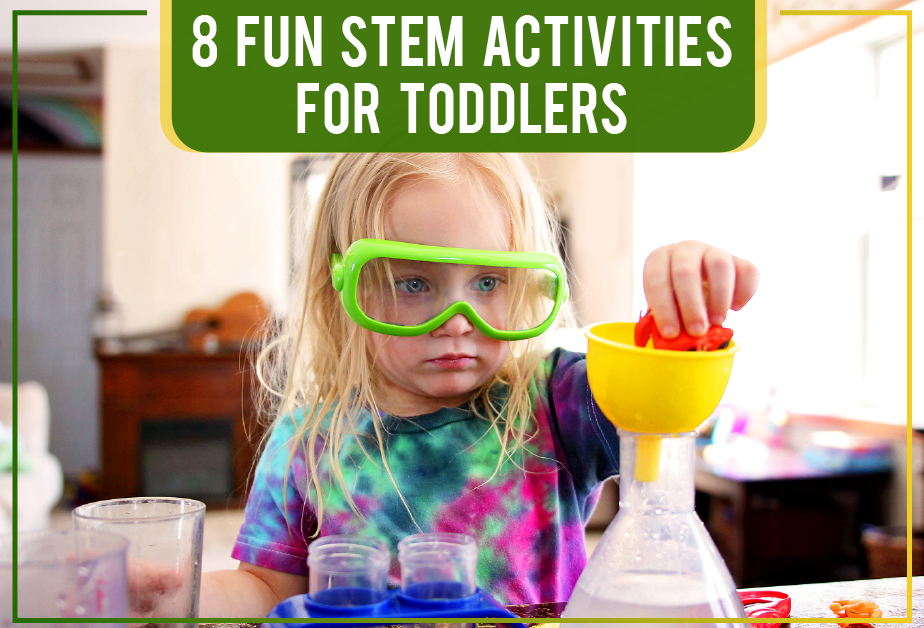8 Fun STEM Activities For Toddlers
Learning about concepts related to the “STEM” subjects (Science, Technology, Engineering, and Math) from an early age is important. But sometimes these subject areas can be tricky for children to comprehend. Most basic STEM concepts are relatively simple. However, some STEM-related activities can be difficult for little children.
STEM education is essential for young kids because it prepares them for their future academics and life after school. The learning does not have to be complicated or boring. It can be made fun and interesting with the help of STEM activities that teach key concepts while engaging children. For toddlers, here are some STEM activities you can add to your list.
1) Measuring with Spoons
You can use kitchen utensils to introduce kids to the concept of measurements, like volume. Encourage children to experiment by seeing if they can fill a jar more than halfway up with water, using only teaspoons (or measuring spoons depending on the child’s age). You can use any container that can hold water. You may even enhance this further activity by allowing your child to fill jars with other materials like flour or sand.
2) Rock Painting
Painting rocks has become a popular trend. It is also a great STEM activity that focuses on mixing colors and fine motor skills. Ask the children if they can figure out which colors can mix together to make other colors, and see if they can mix the necessary colors to create the desired shade. You can even focus more closely on fine motor skills by asking the children to paint the stones using only certain fingers instead of their entire hands.
3) Sand Timers
This STEM activity is a fun way to introduce the concept of time to your child. You can use any type of sand timer in your home, or you can go outside and create your own sand timers composed of different materials (like sand or pebbles). Be sure that your timer has a "flip" feature, as this will make it more engaging for your little one. Ask the children what happens before and after they flip the timer over, and see if they notice any change.
4) Balloon Boats
This STEM activity requires a lot of patience and coordination. You can use water balloons or plastic bags filled with air, sealed tightly, to make your boats float. See if your child can create a boat that will stay afloat for several minutes — start small and gradually increase time. This STEM activity also promotes the development of the fine motor skills of the child. Toddlers may need help popping the balloons, but some of them may already know what to do once the balloons pop! You can also experiment by using different items, like empty plastic bottles instead of balloons.
5) Bubble Painting
Bubble painting is a fun STEM activity that requires mixing colors from primary elements, specifically water and a simple soap solution. Mixing the paint will give you a wide array of colors for bubble painting! This STEM activity enriches the development of children’s motor skills, as well as an understanding of STEM concepts. You can add a STEM-related twist by asking children if the shapes of the bubbles look familiar, or what they think will happen when they blow harder or softer on the bubble wand.
6) Circus STEM Activities
Circus STEM activities are a great way to introduce STEM concepts in a fun and engaging way! You can create a circus STEM activity in your own home just by using everyday household items, like egg shakers, straws, and musical instruments. Ask children what they think will happen when certain actions are performed such as shaking the shaker faster. Will it make a louder sound, or stop playing altogether? This STEM activity helps children build their "theory of mind," which is essential for STEM learning.
7) Puzzles
Jigsaw puzzles are a great STEM activity for toddlers. Puzzles require young children to think critically using trial-and-error. They also boost the development of cognitive skills that support long-term STEM learning. Puzzles foster problem-solving and critical thinking abilities, both of which are important STEM skills. You can set up puzzles for your little one to complete on the floor or a table. And offer assistance if necessary.
8) Water Play
This STEM activity encourages children to experiment with liquids while strengthening their motor skills. You can use water balloons or plastic bottles filled with water and sealed tightly. This is a STEM activity that can also teach cause-and-effect concepts as they observe what happens when they squeeze or pop the bottle. You can also let your child pour water into different containers, like bowls and cups, to see what will happen (for example, water spills out of the cup).
Incorporating STEM lessons in your child's early learning can be simple and fun! With these STEM activities, you can expose your child to a variety of STEM concepts and skills that they will need as they grow.
At Mrs. Myers' Learning Lab, our numeracy program as a whole focuses on mathematical concepts along with student interaction through problem-solving tasks. Students in our math program get the chance to use modern technology by writing and illustrating their own problem-solving book in our patent-pending build-a-book app, which we then print out and give to our students to keep. Visit our website to learn more.





